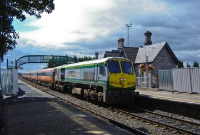201 Class
Built: 1994/5 by GM, London, Ontario, Canada.
34 of these Co-Co locomotives were delivered to Irish Rail in 1994/5, and are the newest and most powerful locos to work in Ireland. The 201 Class quickly began operating services on the principal routes of the Irish Rail system shortly after entering service to places such as Cork, Galway, Waterford Westport, Limerick and Belfast, displacing many 071 Class hauled passenger trains. The 201 Class also hauled Dublin suburban push-pull trains until displaced by 2900 Class railcars in 2002.
The 201s are the heaviest diesel locos to operate on Irish Rail and have a max speed of 100mph, which can be achieved on Dublin-Cork services utilising the Mk4 push-pull rolling stock. The 201 Class also regularly haul the few remaining liner container trains, as well as some timber workings.
Max Speed: 100mph Weight: 112tons Length:20.9
Fitted for multiple operation within the class (not permitted by IE)
34 of these Co-Co locomotives were delivered to Irish Rail in 1994/5, and are the newest and most powerful locos to work in Ireland. The 201 Class quickly began operating services on the principal routes of the Irish Rail system shortly after entering service to places such as Cork, Galway, Waterford Westport, Limerick and Belfast, displacing many 071 Class hauled passenger trains. The 201 Class also hauled Dublin suburban push-pull trains until displaced by 2900 Class railcars in 2002.
The 201s are the heaviest diesel locos to operate on Irish Rail and have a max speed of 100mph, which can be achieved on Dublin-Cork services utilising the Mk4 push-pull rolling stock. The 201 Class also regularly haul the few remaining liner container trains, as well as some timber workings.
Max Speed: 100mph Weight: 112tons Length:20.9
Fitted for multiple operation within the class (not permitted by IE)
















































































































































































